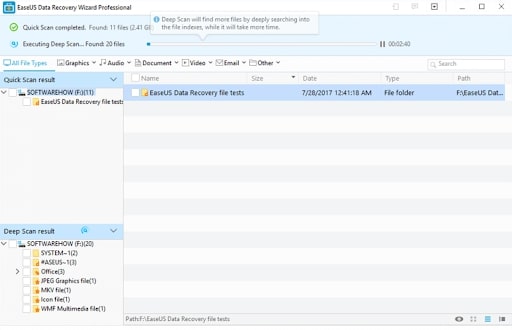Stellar vs EaseUS vs Dr.Fone: What's the best data recovery app for iPhone?
We compare three of the top data recovery apps for iPhones.

There’s nothing worse than finding out that you’re missing important data like photos, text, or contacts from your iPhone. Thankfully, there are data recovery apps you can turn to to get your data back, regardless of whether it was accidentally deleted or lost because of a malicious attack on your device.
To help you find the best data recovery app for your iPhone, we’ve put together an in-depth comparison of Stellar, EaseUS, and Dr.Fone. So, let’s dive into our review to help you determine which of these apps can help you get your data back.
- The best data recovery software of 2020: Paid and free file recovery solutions
Stellar, EaseUS, and Dr.Fone are compatible with both Windows and Mac desktops and work with any iOS device, including iPhones, iPads, and iPods. They all come with impressive scanning capabilities and can restore just about any file format from your iPhone.
All three are similar in that they allow you to recover data from your iPhone in three different ways. You can connect your device directly to your computer to scan the hard drive, recover data from iCloud backups, or unlock encrypted iTunes backup files.
Dr.Fone is one of the best options if you’re looking for specific files. The platform enables you to limit your search to specific file types and then preview the recovered files before restoring them to your device. Stellar and EaseUS will also let you specify what file types to scan for, but their preview options aren’t as robust.

That said, Stellar and EaseUS both offer basic and deep scan options, while Dr.Fone only offers a basic hard drive scan. With a deep scan, the software can identify and attempt to recover files that have been overwritten. Thanks to this feature, we would recommend either Stellar or EaseUS if you’ve lost data to malware or need to access an older version of a file from your device.
Performance
We tested out Stellar, EaseUS, and Dr.Fone by deleting a selection of 20 photos and dozens of text messages from a single 64 GB iPhone 8. We then connected the device to a Windows desktop and ran scans to determine whether each platform could recover the files.
Are you a pro? Subscribe to our newsletter
Sign up to the TechRadar Pro newsletter to get all the top news, opinion, features and guidance your business needs to succeed!
All three successfully retrieved newly deleted data even when only running a quick scan within EaseUS and Stellar. The process took around 20 seconds for EaseUS and 30 seconds for Stellar and Dr.Fone. Once the files were recovered, all three platforms enabled us to restore them to the device or copy them onto the desktop. There was no noticeable loss in quality in any of the photos and all of the text messages were fully readable.
We also tested the deep scan functions in EaseUS and Stellar. EaseUS took around 35 minutes to complete the scan and never used more than 25% of the computer’s CPU power. However, Stellar’s deep scan took close to two hours and used upwards of 40% of CPU power throughout the scan. Both deep scans recovered the deleted photos and text messages, along with hundreds more files that had been deleted over the past several months.

Overall, we would recommend EaseUS based on performance. While all three platforms were able to recover the test files, EaseUS includes a relatively fast deep scan that doesn’t demand a lot of computer resources.
Support
All three platforms offer several options for technical support. You can get in touch with Dr.Fone by email or phone from 9 PM to 2 PM Eastern. The company’s website also includes extremely detailed tutorials complete with short walkthrough videos.
EaseUS offers live chat, email, and phone support. Chat support is only available in the middle of the night for US users, from 9 PM to 5:30 AM Eastern, while phone support is available from 9 PM to 10 AM Eastern (both Monday to Friday only). The online knowledgebase is slightly difficult to navigate, but it includes a number of video tutorials.
Stellar offers the best support, in our opinion. US users can reach US-based technical support staff, and the company has specific phone numbers for UK and Australian users. The online documentation is extremely helpful and includes screenshots and video tutorials specifically for iPhone data recovery.

Pricing and plans
Unfortunately, recovering your data with Stellar, EaseUS, or Dr.Fone isn’t cheap. EaseUS is the only one of these platforms to offer a free plan, and it limits you to restoring just five contacts and a single photo or video. The paid version of EaseUS costs $69.95 for Windows computers or $89.95 for Macs and doesn’t place any restrictions on the number of devices you can connect.
Stellar offers annual or biannual licenses for $39.99 or $59.99 respectively. These plans come with unlimited data recovery but limit you to connecting five different devices. If you need to recover data from a large number of iPhones, Stellar offers a Technician plan for $99.99. This is a one-year license and enables you to recover data from up to 50 devices.
Dr.Fone offers a one-year license for $59.95 on Windows or $69.95 on Mac. You can also opt for a lifetime license for $69.95 on Windows or $79.95 on Mac. These licenses enable you to recover data from up to five devices.
Verdict
Stellar, EaseUS, and Dr.Fone are all excellent choices for recovering data from an iPhone. Dr.Fone makes it easy to recover specific files, while Stellar and EaseUS both offer deep scan capabilities to help you restore data that’s been overwritten. Overall, we think EaseUS is the best data recovery app for iPhones because the deep scan runs quickly and an unlimited lifetime license is priced inexpensively relative to Stellar and Dr.Fone.
- The best data recovery software of 2020: Paid and free file recovery solutions
Michael Graw is a freelance journalist and photographer based in Bellingham, Washington. His interests span a wide range from business technology to finance to creative media, with a focus on new technology and emerging trends. Michael's work has been published in TechRadar, Tom's Guide, Business Insider, Fast Company, Salon, and Harvard Business Review.
